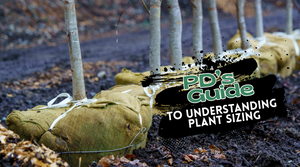Downy Serviceberry
Downy Serviceberry (Amelanchier arborea)
Downy Serviceberry (Amelanchier arborea) is a versatile native tree or large shrub that offers four-season beauty, ecological value, and landscape adaptability. Known for its early white blossoms, edible summer fruit, and brilliant fall color, this North American native is prized in both naturalistic and formal gardens. Its refined habit and multi-season interest make it a popular choice for residential and wildlife-friendly landscapes alike.
Distinctive Features
Growing 15 to 25 feet tall with a similar spread, Downy Serviceberry forms a rounded to upright canopy with smooth gray bark and fine branching. In early spring, delicate clusters of five-petaled white flowers emerge before the foliage, often marking one of the first floral displays of the season. By summer, the blooms give way to small, red-to-purple berries that are edible and attractive to birds. Fall foliage ranges from orange to brilliant red, offering a second wave of seasonal interest.
Growing Conditions
- Sun Exposure: Full sun to partial shade; best flowering and fruiting in full sun.
- Soil: Prefers moist, well-drained soil rich in organic matter; tolerates clay and loam.
- Water: Moderate; appreciates regular watering in dry periods, especially when young.
- Humidity: Performs well in both humid and temperate zones.
- USDA Hardiness Zones: 4 - 9; highly adaptable and cold hardy.
Ideal Uses
- Focal Point Plantings: Showy blooms and seasonal interest make it a dynamic centerpiece.
- Native and Wildlife Gardens: Berries attract birds and pollinators; supports regional biodiversity.
- Understory Tree: Works well beneath taller canopy trees in woodland settings.
- Foundation and Border Plantings: Softens hard edges and adds texture throughout the year.
- Rain Gardens and Low Spots: Tolerates occasional wet soils and supports stormwater management.
Low Maintenance Care
Downy Serviceberry is easy to grow and maintain, needing only minimal care once established. Its natural resistance to pests and diseases adds to its suitability for low-maintenance and sustainable landscapes.
- Watering: Water consistently during the first few seasons; drought tolerant once established.
- Pruning: Prune in late winter to maintain structure or remove any suckers or deadwood.
- Fertilizing: Apply compost or a balanced fertilizer in early spring for best performance.
- Pest and Disease Resistance: Generally resistant, though occasional rust or leaf spot may occur in humid regions.
- Winter Care: Fully hardy with no special winter protection required in its zone range.
Why Choose Downy Serviceberry?
Downy Serviceberry offers native charm, ecological value, and year-round beauty. Its modest size, edible fruit, and tolerance of a range of conditions make it a top choice for gardeners looking to support wildlife while adding elegance and seasonal interest.
- Early Spring Flowers: Among the first trees to bloom, offering delicate white blossoms.
- Edible Summer Berries: Sweet, blueberry-like fruit enjoyed by people and birds.
- Brilliant Fall Color: Vivid orange and red foliage extends the season of interest.
- Adaptable Growth: Suitable for both urban and rural settings; tolerates clay and part shade.
- Native and Wildlife-Friendly: Supports pollinators and birds with minimal care.
For natural beauty, multi-season appeal, and ecological value, Downy Serviceberry (Amelanchier arborea) is a standout performer in gardens across North America.

OUR SIZING
Not sure what 2 inch B&B or 30 Gallon Clump really means? This guide breaks down all our plant size terms so you know exactly what to expect, whether you're ordering online or picking up at our nursery. From caliper measurements to container volumes, we've decoded our system to help you shop with confidence.

Plant Detectives Shipping Guide
Nationwide plant shipping made easy. Learn how we ship trees, shrubs, annuals and perennials. No order too big or too small. Fast, careful, and contractor-friendly.

